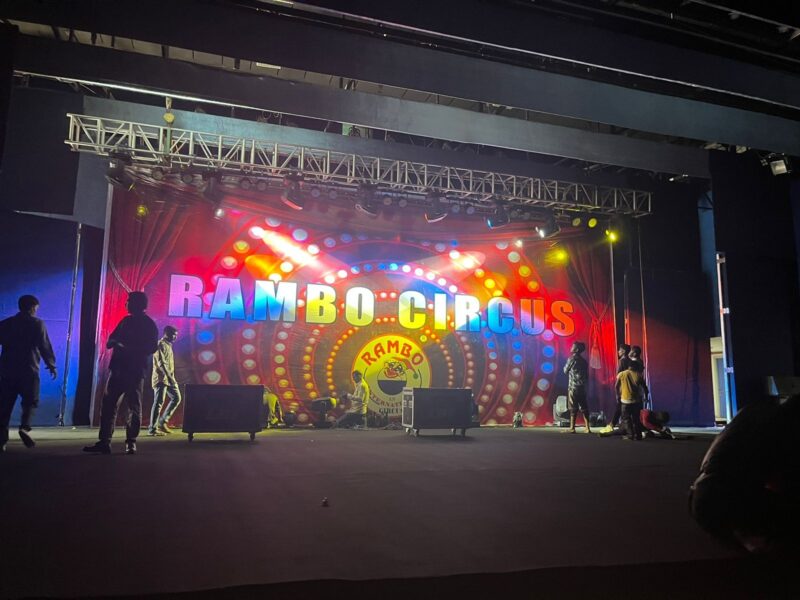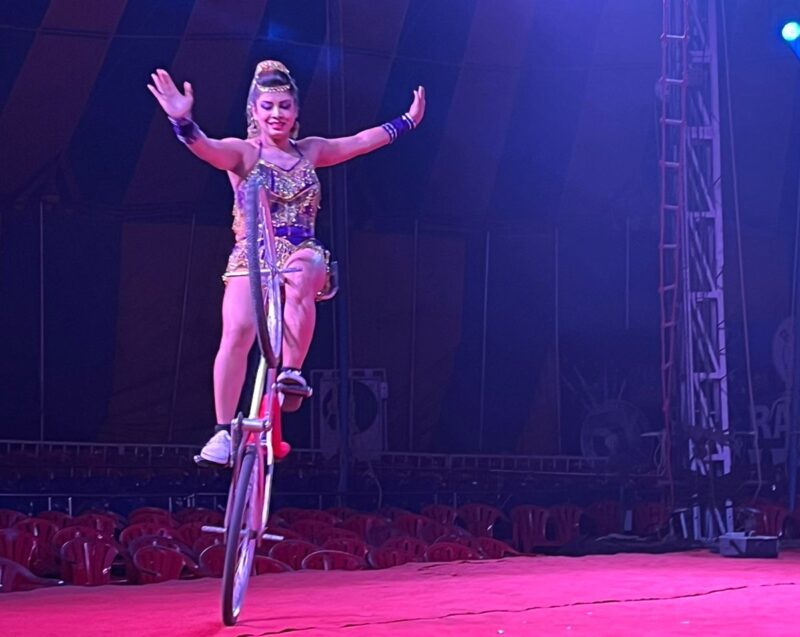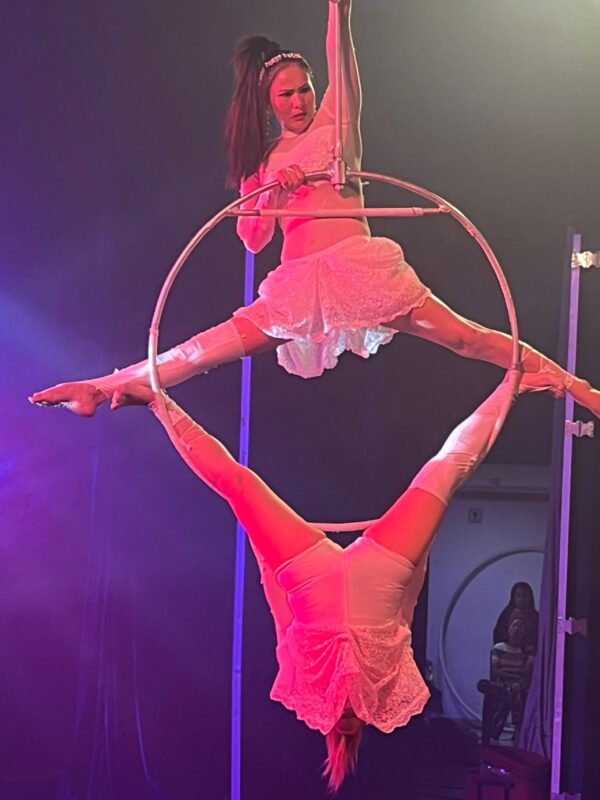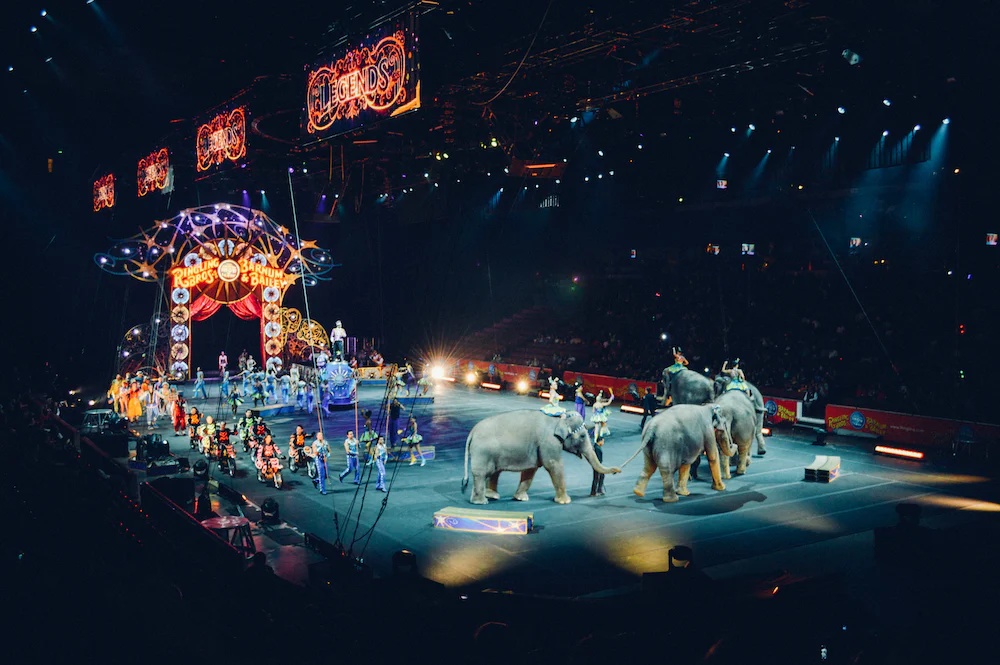It is 5 am. Sleepless Biju Pushkaran, a senior clown at Rambo Circus is preparing a group of performers for his next show at Chetpet in Chennai.
He has already wrapped up the four-day ‘International Circus Festival’ at Siri Fort Auditorium from May 25 to May 28.
“Delhi never disappoints and I had a great time. The air-conditioned auditorium was packed with people of every age group. We featured the classic acts including juggling, mono-wheel cycling, acrobatics in the festival in addition to the clown’s act,” says Pushkaran as he packs his bags at Sai Dham in Delhi.
Formed in 1991 by late PT Dilip, Rambo Circus has completed 32 years. From makeshift tents while travelling to different locations to taking it online and theatres — it is a journey of commitment and passion towards a traditional art-form.
“People say circus is dead. Why don’t they see that art can never die. I, along with my team, are trying our best to keep this art alive,” says Sujit Dilip, son of PT Dilip, who is the proprietor of the circus now.

Rambo Circus was formed after the late PT Dilip merged Erina Circus, the Great Oriental and Victoria Circus. The circus created history when it took the art-form, usually showcased in outdoor setting, to an indoor set-up in Mumbai’s Prithvi Theatre in 2012.
“We have to keep innovating and work harder to find newer audience. Keeping up with the trend and time is important. Over the years, circus has evolved into different forms of expression. To say that the circus industry is struggling is not wrong. But the thing is that circus is struggling as a setting and not as an art-form. By this I mean, now we don’t have physical space due to urbanisation and setting up a circus requires a large portion of land. But that doesn’t mean people have stopped loving circus. They still love watching the clowns act and it brings smiles on their faces,” says Sujit.
Pushkaran explains that he has been trying his best to bring back performers who have left circus.
He says, “I want this art-form to never die. I try to take care of my team as much as possible. I provide them food, financial assistance and emotional support in order to motivate them to keep continuing. It is difficult to convince them because people have started opting for alternative job opportunities in the cities. To be honest, there’s no dearth of work especially in cities and therefore, the circus folks move out.”
Vatsal Nand, a 37-year-old former acrobat, who has performed at several international festivals is nowadays picking odd jobs for survival.
“I quit the circus industry five years ago as I could sense there’s no future. I am a watchman now. I miss the circus life, living with the troupe. I have a family to feed and I realised that circus is no longer the first option for entertainment for people now. The audience is lost.”
The road-blocks
Arun Kumar (name changed upon request) works as a photojournalist and has spent four years on a project covering the circus industry.
Kumar says, “Even though the circus industry is trying to revive and sustain, there are several factors for its downfall. For instance, the absence of animals is one of the major reasons why audience’s interest has dipped.”

From bears, monkeys, tigers, panthers, to lions, one could witness all the animals in a circus. But in 1998, after year-long inspections in which extreme animal cruelty was reported in the circus premises, animals were banned from performing for entertainment purposes in India.
Elephants were exempt from this law and the spectators enjoyed the sight of an elephant juggling or simply lifting a ball. In 2013, even hopes of catching a mere glimpse of an elephant in the circus came to an end.
Kumar closely interacted with the circus folks and according to him, the society needs to focus on what the owners of the animals say.
Kumar explains, “I firmly believe that cruelty done to animals should be punishable. It is unethical. But we need to hear the other side as well. A few years ago, one of the elephants who was born and brought up in the circus was taken away from Rambo Circus. We need to understand that those animals who are born in the circus have a lifelong bond with their owners. By taking such animals away from the owners, the authorities are doing more harm than good.”
In April 2011, the Supreme Court of India banned the employment of children in circuses and directed the Union government to take immediate steps to rescue and rehabilitate minors.
“We need to train the kids at an early age because art needs years of practice. Training begins at this age because the acts demand different set of skills. Acrobatics need rigorous training and commitment. We see children working in TV and film industry and they are of course below the age of 18. Then I ask why this restriction has been put only on us? Our children are not doing any labour, they are child artists. Despite all the efforts made by the circus industry, the government pays no heed to the needs of the artists,” shares Rajiv Armand Alexander, 40, a representative of Ajanta Circus.
Established in the year 1967 by Abdul Aziz, with only Rs. 5000, the circus has made a comeback after the pandemic.
Alexander adds, “We are running solely on human performances since animals are no longer a part of circus now. The pandemic came as a blow and it was extremely difficult for us to keep floating without support from the government. However, we kept training the members because we had hope that we would perform again. Acrobats became the back-bone of circus industry after animals were stopped. It is about performing unimaginable acts and acing the act on stage which can pull the crowd.”
Alexander observes that a large number of artists comprised children between six and 15.
Children necessary in circus
While circus owners agree that education is key and that children shouldn’t be forced to work in circus, they also believe that children are born as artists in the circus industry since it is an art that is passed from one generation to the next.
“What about those who are passionate about it since a young age? Do we not appreciate young kids going in singing competitions or talent shows? Then why not circus?” says one.
Since the law discourages recruitment of children in circuses, several trained kids aged 12 to 14 are sitting at home and can’t practice or perform. While some went back to their villages to support their families, others are working as street vendors.
Also, organising a circus has become a costly affair.

The audience has reduced drastically and private land owners are charging hefty amount for accommodation. The rent is high and consequently, the circus industry is not able to run the business properly.
Pandemic put the last nail in the coffin as everything came to a pause. Many circuses had to shut down and the owners had to look for other jobs to earn their bread and butter.
Pushkaran from Rambo Circus says, “Many of our artists have left the circus, and now we are working with approximately 200 people. The staff strength was 400-500 earlier. Many artists went into depression during the pandemic. It was a time of great distress. We didn’t know when would we be able to perform and most importantly, how are we going to fill our stomachs. We used our savings and helped each other. We also got immense support from Dilip Saab as he gave us money to buy vegetables and other necessary stuff for survival in the lockdown phase.”
One of the reasons for this condition, as Pushkaran highlights, is lack of support from the government.
“Things became worse with the imposition of GST (Goods and Services Tax) on minimum price ticket for the shows. One of the factors why the circus industry gained traction in the early days were the affordable tickets. Everyone would have the financial capacity to spend a few rupees on the ticket. This GST has affected the prices and the entire budget on which we plan out our shows. There’s no subsidy or for that matter any helpful policy. We travel with the troupe to different cities and it’s important that we get financial assistance. Earlier, we also didn’t have any life insurance policies but now it has become the need of the hour.”
Pushkaran is all set to come back to Delhi on the Dussehra festival.
Walking the road less travelled
A WhatsApp message on BS Reddy’s phone reads, “I lost my mother. Can you help me bring her back?”
Another one reads, “I am battling depression due to my physical appearance. My height is an issue. I have seen you perform miraculous things on television. Can you please help me?”
BS Reddy receives these kinds of messages from people every day.
“Mind you, these people are well educated and working in the corporate sector,” cautions Reddy, an independent illusionist.
The idea of entertainment is evolving every single day.
“Now the audience is no longer the kind that would be surprised if I simply make afloat a pencil in my palm or levitate someone. A magic show is engaging only when the illusionist is smarter than the audience. These days everyone has access to smartphones and end up researching in depth about anything they wish to know. If they happen to know the trick already, then there’s no point in the magic. One of the major challenges for an illusionist is to surprise the audience by performing clever acts. One can’t do it without proper knowledge which comes only when we walk along with time. Adopting newer techniques is crucial.”
These days magicians are finding different ways to showcase their talent and make money.
Social media platforms are perhaps the most engaging way to reach out to people. One can make good money by simply putting out engaging content. There are corporate shows where brands invite Reddy for product launches.

“When a company wants to launch a product in market, it sometimes looks up to a magician. Magicians are designing acts to launch their product though magic,” tells Reddy.
He is often invited at birthday parties to perform.
The circus industry also took the virtual route to sustain in the world.
Rambo Circus has organised several shows and magic classes online which helped them to not just earn money but also engage with the audience. While the future can’t be predicted, all the circus folks are hopeful that they would be able to bring back the lost charm of circus.





